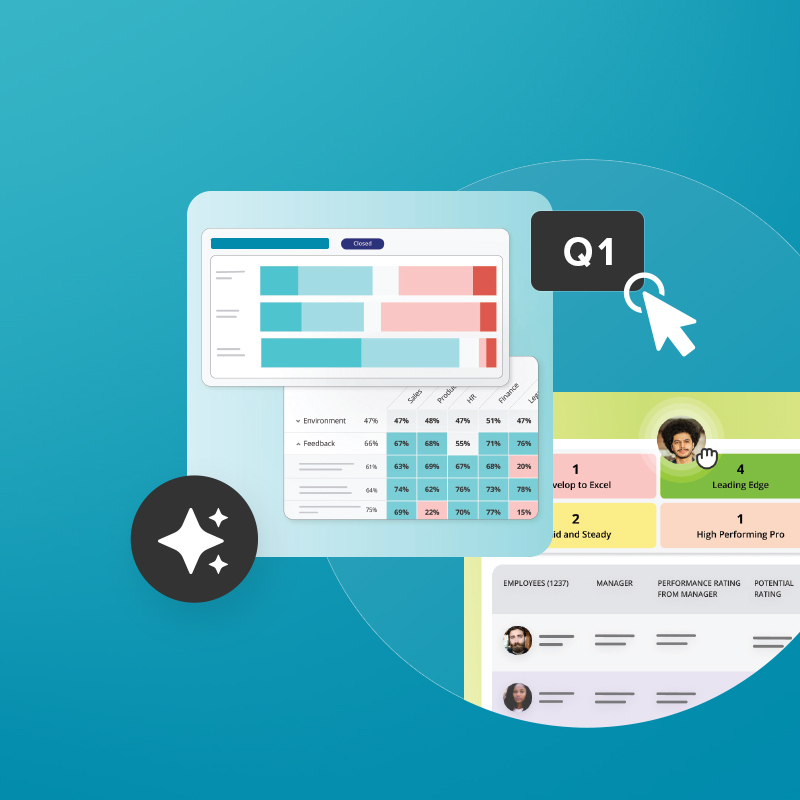Employee performance appraisals significantly boost both business performance and employee engagement — if you use them effectively.
That’s because, according to our 2024 State of Performance Enablement report, employees who see performance management processes as successful are more likely to feel productive, confident, and hopeful. However, nearly half (46%) of employees who don’t have access to effective performance management processes find performance reviews to be a waste of time.
So how can you turn employee performance appraisals from a dreaded routine to a game-changing element of your performance management program?
Learn best practices for employee performance appraisals to boost engagement and productivity.
Understanding employee performance appraisal
Employee performance appraisals are scheduled reviews in which managers evaluate the performance of their team members. These appraisals help managers understand each person’s contributions, strengths, and areas for improvement and provide a place to discuss progress, set goals, and find ways to support further development.
Performance appraisals shouldn’t simply review and critique past performance. Their greater purpose is to recognize each employee’s efforts, address performance opportunities, and guide them to grow within the company.
More importantly, performance appraisals help you measure and understand the impact each employee has on the organization, says Caitlin Collins, organizational psychologist and program strategy director at Betterworks. “I still have influence, no matter where I sit within the organization,” she says. “My sphere of influence, even if it’s small, is still aligned with my job function — and there’s value.”
4 key components of an effective performance appraisal
What goes into a good performance appraisal process? Let’s explore four key aspects of high-impact, meaningful appraisals to include in your employee performance appraisal template.
Ongoing feedback
Regular feedback in between formal appraisals keeps evaluations effective and relevant. Managing employee performance through ongoing feedback can help team members improve throughout the year, turning scheduled appraisals into part of a continuous development cycle.
Integrating regular feedback fosters open communication and trust. Employees better understand their strengths and areas for improvement, reducing surprises during formal reviews. This proactive approach keeps everyone aligned with organizational goals, leading to a more engaged and high-performing workforce.
Comprehensive evaluation criteria
Clear and detailed criteria let employees know how they’re being evaluated during the appraisal. Base performance criteria on specific job descriptions. Employees should already be familiar with these basic performance expectations, so they won’t feel like they’re walking into any surprises.
Detailed criteria also help managers provide more constructive feedback. Instead of vague comments, managers can offer specific examples and actionable advice. Pointing to specific criteria makes feedback more useful and helps employees make meaningful progress.
Employee involvement
Involving employees in the appraisal process encourages them to own their role in the company. When employees actively participate in the appraisal process, they feel more invested in their goals and progress. The process becomes more constructive and collaborative instead of punitive. It’s a conversation, not just a manager running through a list of items the employee did wrong.
Clear and specific goals
Clear and specific goals give direction and purpose to the performance appraisal process. Goals refer to both employee performance goals and your broader goals for the overall performance appraisal process.
“You’ve really got to map it out from the very beginning to have it be something that’s valuable and meaningful,” Caitlin says. Without well-defined goals, both managers and employees may struggle to understand what they are working toward, leading to vague feedback and unclear expectations
Setting clear goals aligns the appraisal process with broader business goals. Whether the aim is to identify candidates for succession planning or to change employee behaviors, having specific goals helps managers and employees ask the right questions and measure the right things. This clarity makes for a more effective and meaningful appraisal process.
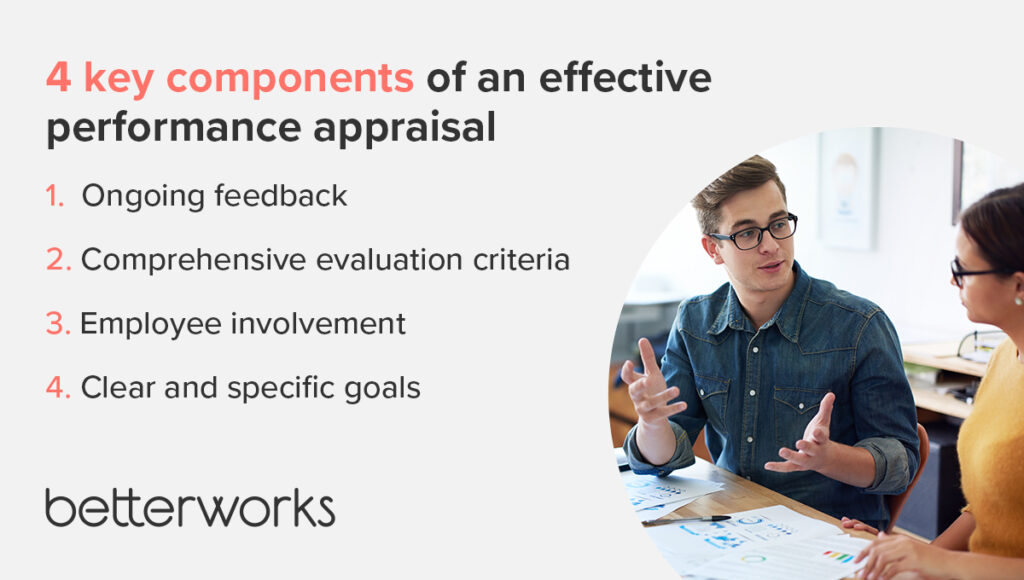
4 performance appraisal methods
Choosing the right performance appraisal method is key to effective employee evaluation. Each method has its own benefits and problems, so it’s important to know how they work and how you can use them in your company. Let’s dive into four popular methods and see how they can enhance your appraisal process.
360-degree feedback
360-degree feedback is a performance appraisal method where employees receive confidential, anonymous feedback from the people they work with. This includes peers, direct reports, and managers. Unlike traditional reviews in which an employee only receives feedback from their manager, 360-degree feedback incorporates feedback from their colleagues and other stakeholders.
By gathering input from various sources, 360-degree feedback can theoretically provide a more balanced and accurate assessment. It highlights areas of strength and pinpoints areas for improvement that might not be visible in a standard review. The downside of this type of employee performance appraisal system is that it involves a lot of people, which can make it time-consuming and costly to pursue.
Self-assessment
Self-assessment is a performance review process in which employees evaluate themselves. This method encourages employees to reflect on their successes, challenges, and areas for improvement. By evaluating themselves, employees can identify their strengths and weaknesses, set goals for themselves, and take responsibility for their own growth.
Employee self-assessments give managers valuable insights into how employees feel about their own performance, opening up better communication. These conversations give managers the chance to address any challenges employees are facing so they can collaborate to improve performance continuously. The disadvantage of employee self-assessments is that employees may believe their performance is stronger than it actually is. If this is the case, managers will need to be ready to provide a clear and accurate explanation for why their evaluation differs from their employees’.
Management by objectives (MBO)
Management by objectives (MBO) is a performance management approach where managers and employees set clear, specific goals together. The framework operates based on defined outcomes that team members should achieve within the review period.
During appraisals, managers and employees review the goals they’ve set, discuss the progress the employee has made, and identify any obstacles. This approach keeps evaluations fair and focused on clear results that match the organization’s goals. It also promotes regular communication and teamwork between managers and employees, making the appraisal process more organized and goal-driven.
However, because it’s so focused on results, this method may miss opportunities to suggest new ideas or problems with the work process.
Rating scales
Performance rating scales are tools used to evaluate employee performance based on specific criteria, such as productivity, quality of work, and teamwork. Each aspect is rated on a scale, usually from failing to meet to exceeding expectations.
Rating scales are intended to give more structured feedback and allow for fair comparisons between employees. However, different managers may interpret and apply rating scales differently, which can produce inconsistent results and even lead to bias.
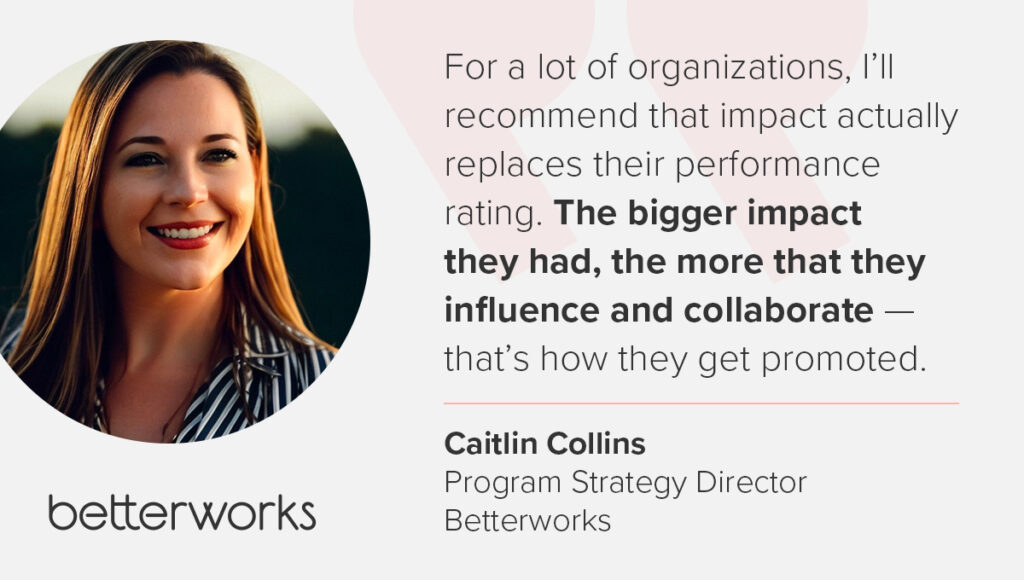
Given this drawback, Caitlin suggests shifting from numerical rating scales to measuring each person’s impact on business outcomes for a fairer assessment of performance. “For a lot of organizations, I’ll recommend that impact actually replaces their performance rating,” Caitlin says. “The bigger impact they had, the more that they influence and collaborate — that’s how they get promoted.”
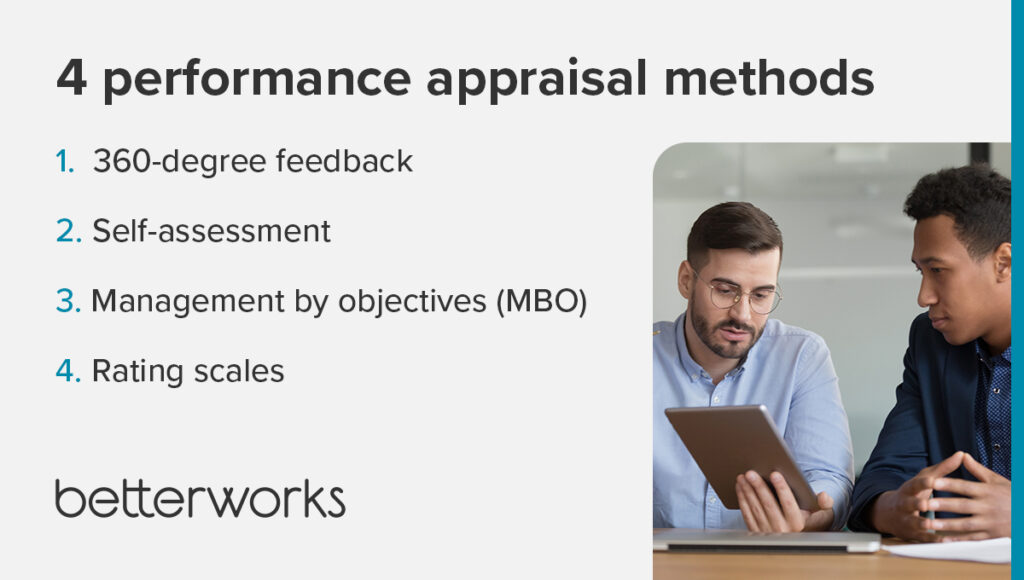
4 best practices for performance appraisal
Performance appraisals are only useful when they’re designed and deployed with intention. By following these best practices, you can design, implement, and facilitate a performance appraisal process that truly benefits your organization and its employees.
Train managers
Effective performance appraisals start with well-trained managers. They are the ones completing the employee performance appraisals, so equipping them with the right skills and knowledge is crucial. Provide training on how to give constructive feedback, collaborate with employees to set realistic goals, and develop effective performance improvement plans. Prepared managers conduct a smoother and more productive appraisal process, leading to better outcomes for everyone involved.
Communicate with employees
Clear communication can make or break the performance appraisal process. First, take time to share how the process works, and how often employees should meet with their managers for formal appraisal conversations. Regular check-ins and open lines of communication help employees feel more engaged and less anxious about their appraisals.
Employees also need to know how their performance is being assessed, and what the results of the assessment mean for them. How does performance appraisal tie into employee development or promotion opportunities, for example? When expectations are clear, employees are more likely to appreciate and apply the feedback they receive.
Assess and improve the process
No process is perfect, and performance appraisals are no exception. Regularly evaluate how the appraisal process is working within your organization. Gather feedback from both managers and employees to identify areas for improvement. Use this feedback to make any necessary changes. Keeping an eye on and improving the process keeps it current and useful, meeting the changing needs of your organization.
Use the right technology
Incorporating the right technology can revolutionize your performance appraisal process. Numerous tools are available to help with performance tracking, setting goals, and managing feedback. These tools can save time, reduce errors, and provide valuable insights into employee performance. Generative AI, for example, when used within a performance management tool, can summarize performance conversations, feedback, and goal accomplishments to provide a comprehensive view of an employee’s efforts and impact. Using the right technology makes the appraisal process more efficient and data-driven, leading to better decision-making and more accurate evaluations.
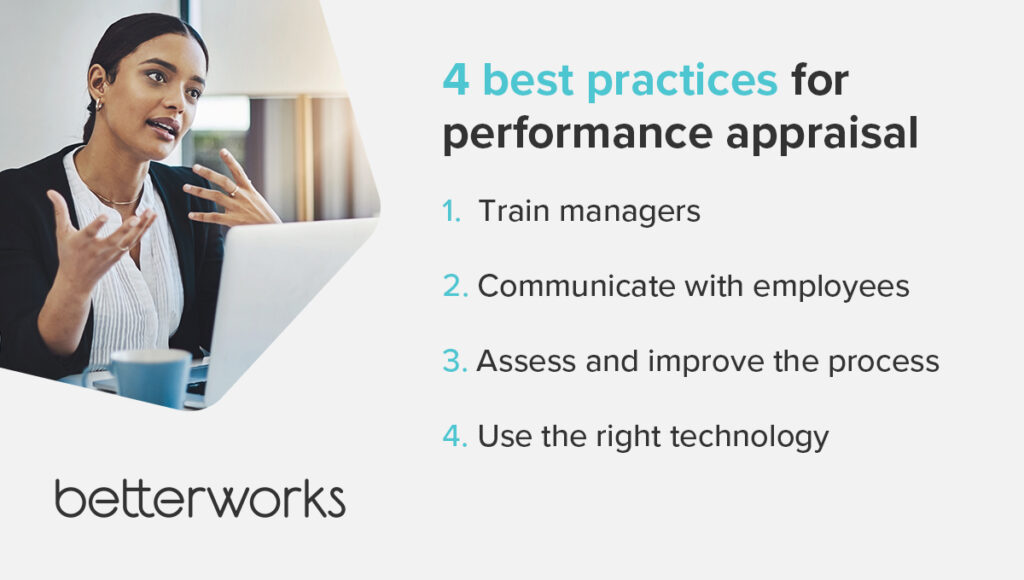
3 employee performance appraisal examples
Check out these performance appraisal examples showcasing strengths, areas for improvement, and future goals. These examples provide a clear and structured way to evaluate employees, offering constructive feedback to help them grow and succeed. Each example focuses on different roles and showcases how targeted feedback can drive performance and development.
Software developer
John has exhibited exceptional technical skills and played a vital role in meeting project deadlines by releasing new software. While maintaining a high standard of code quality and demonstrating proactive bug-solving skills, I encourage John to enhance his teamwork abilities by increasing collaboration with colleagues. To achieve this, he should actively engage in team meetings and collaborate on a project with a minimum of two other team members in the upcoming quarter.
Customer service representative
Sarah has shown exceptional customer service skills by maintaining a 95% customer satisfaction rate this quarter. While her patience and empathy are commendable, it is vital for her to work on reducing the average call-handling time to enhance efficiency further. In the upcoming months, Sarah aims to decrease her average call-handling time by 10% and complete a comprehensive product training course to strengthen her problem-solving abilities.
Marketing manager
Mark successfully led the launch of the new marketing campaign, resulting in a 20% increase in lead generation, demonstrating strong strategic planning and team leadership skills. To further enhance his impact, I recommend that Mark focus on improving his reporting and data analysis abilities to deliver more comprehensive insights on campaign performance. Over the next three months, Mark will attend a data analysis workshop and familiarize himself with a new reporting system specifically for marketing campaigns. These proactive steps will enable him to effectively monitor and assess the success of campaigns.
Elevating performance appraisals for success
Effective performance appraisals drive business success and boost employee engagement. When done correctly, these appraisals provide clear and actionable feedback, helping employees understand their strengths and areas for improvement. This clarity not only motivates employees to perform better but also aligns their efforts with the organization’s goals.
Performance appraisals also foster open communication between managers and employees. Regular, constructive feedback builds trust and helps employees feel valued. This ongoing conversation keeps employees engaged and committed. It also helps to reduce turnover and make employees more satisfied at work.
For HR leaders, implementing a robust appraisal process is an investment in your organization’s future. It creates a culture of continuous improvement and accountability, leading to higher productivity and better business outcomes. By prioritizing effective performance appraisals, you can cultivate a more motivated, high-performing workforce that drives your company forward.
Ready for a better way to do performance evaluations?




